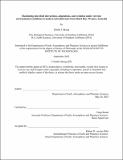Elucidating microbial interactions, adaptations, and evolution under extreme environmental conditions in modern microbial mats from Shark Bay, Western Australia
Author(s)
Skoog, Emilie J.
DownloadThesis PDF (32.30Mb)
Advisor
Bosak, Tanja
Terms of use
Metadata
Show full item recordAbstract
Fossilized microbial mats dating back 2+ Ga record some of the earliest evidence of life on Earth. These ancient pustular mats preserve evidence of microbial production of extracellular polymeric substances (EPS), revealing the potential importance of EPS in the protection and preservation of these ancient microbial communities. Today, extant pustular microbial mats in Shark Bay, Australia serve as one of the best modern analogues of these ancient systems. These modern microbial communities are able to persist in the extreme environmental conditions (i.e., hypersalinity, periodic desiccation, UV radiation, heavy metal toxicity) that characterize these past and present environments due to the EPS that coat and protect these microbes. The ability to produce, degrade, and modify EPS may advantage certain microbial communities and consequently support synergistic cooperations and influence overall community structure, yet these interactions remain unexplored. Additionally, the inter-exchange of evolutionarily useful genes over billions of years may have enabled the adaptation and evolution of this community to such environmental extremes. This thesis uses metagenomic and biogeochemical analyses to elucidate how modern pustular microbial mats have persisted and adapted to survive extreme environmental conditions for over two billion years.
In this thesis, I merge metagenomic analyses with experimental data to i) analyze the composition of EPS produced by cyanobacteria enriched from these microbial mats, ii) link these findings with metagenomic potential of the heterotrophic microbial community to modify and degrade this EPS, and iii) infer potential microbial interactions facilitated by the cycling of EPS and within this community. I further explore the presence and cycling of sulfated EPS within this pustular mat and determine the role that sulfated EPS may play in overall microbial community structure and protection from harsh environmental conditions. Metabolic reconstruction of poorly-characterized members of the rare biosphere is then used to i) determine the functional role of these bacteria within the pustular mat community for the first time and ii) infer the adaptational mechanisms for stress responses of these organisms within this extreme environment as well as other localities within which these candidate phyla have been identified. Finally, horizontal gene transfer (HGT) analyses are used to predict microbial interactions and determine relative timing of transfer events of evolutionarily useful genes that may confer microbial resistance to a range of environmental stresses. Combining these various approaches and techniques enables a better understanding of how microbial metabolism, metagenome plasticity, and microbial adaptation may inform the ecological success and evolution of an ancient microbial community under environmental extremes.
Date issued
2023-09Department
Massachusetts Institute of Technology. Department of Earth, Atmospheric, and Planetary SciencesPublisher
Massachusetts Institute of Technology